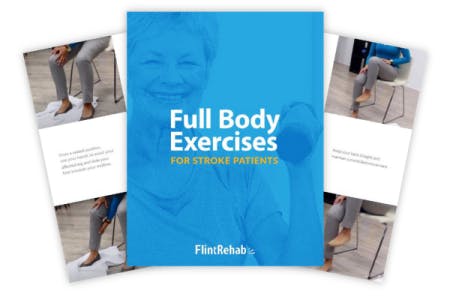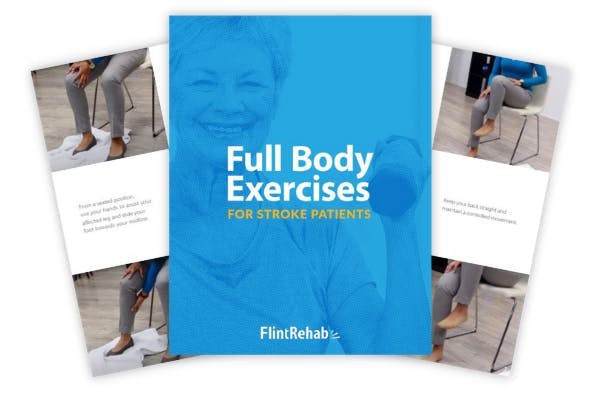No products in the cart.
No products in the cart.
No products in the cart.
No products in the cart.
Home » Neurological Recovery Blog » Traumatic Brain Injury » TBI Rehabilitation » Anomic Aphasia: Understanding the Causes, Types, & Rehabilitation Process
Last updated on August 24, 2022

Anomic aphasia is a language disorder that causes difficulty with word-finding or naming items. This condition, also known as dysnomia, can occur after a stroke, traumatic brain injury, or other neurological conditions.
Individuals with anomic aphasia usually feel as though they have the word(s) at the tip of their tongue but struggle to recall the exact word. Although anomic aphasia is one of the mildest forms of aphasia, speech therapy is essential in order to improve this condition.
This article will discuss the causes of anomic aphasia, and how a proper rehabilitation plan can help improve speech & language skills and promote recovery.
Aphasia refers to a class of communication disorders that occur when the language center of the brain becomes damaged. Anomia refers to the persistent inability to find the correct word and it’s a typical symptom of aphasia. Anomic aphasia in particular causes difficulty with word retrieval, usually nouns and verbs.
Individuals with anomic aphasia can usually describe the function of an object but not the name. Their speech is also full of vague words and circumlocutions, or the use of an unnecessarily large number of words to express an idea.
For example, instead of naming a “zebra” they may say “a black and white animal that looks like a horse.” However, people with anomic aphasia can still speak fluently and comprehend sentences, unlike expressive aphasia, where individuals speak in short, effortful sentences.
Common causes of anomic aphasia include:
Anomic aphasia is typically caused by damage to the left hemisphere of the brain, the control center for speech and language. In some rare cases, anomia can be caused by damage to the right hemisphere of the brain. Additionally, there are different types of anomic aphasia that each present with different symptoms.
There are various types of aphasia, some more severe than others. The mildest type of aphasia is anomic aphasia, which can be classified into several different subtypes.
The most common types of anomic aphasia include:
Word selection anomia is the most common type of anomic aphasia. Individuals with word selection anomia are able to recognize objects but have difficulty recalling the name, even with assistance. For example, an individual may know what a computer is used for but is unable to name it.
Semantic anomia is another type of anomic aphasia that causes difficulty identifying an object, even when given the name. For example, if you ask an individual to point to a pencil in a stack, they may have difficulty differentiating it from other objects.
Word production anomia is the mildest form of anomic aphasia. Survivors with this condition often feel like the word is at the tip of their tongue. Although they have trouble producing the name of an object, they are able to recognize and retrieve the right word with correct prompts.
Disconnection anomia is another type of anomic aphasia that occurs when the communication between the sensory and language areas of the brain become damaged. The left side of the brain processes language, while the right side of the brain processes sensation.
Thus, when the neural pathways (connections) between the left and right hemispheres are interrupted, it can result in language difficulties such as anomia.
Disconnection anomia can be broken down into three subcategories:
Although there are various types of anomic aphasia, most can be improved with a proper rehabilitation plan. However, an accurate diagnosis is needed in order to receive the appropriate treatment.
To provide you with a proper diagnosis, your doctor may perform various anomia aphasia tests. This can include a series of verbal and brain imaging tests that can help eliminate any other disorders that may be causing anomia symptoms.
For example, an MRI scan will look for brain damage in the left hemisphere. However, with anomia the damage is often mild and inconsistent and therefore may not appear on a brain scan.
Therefore, doctors will also recommend verbal tests. These tests can further determine whether the problem is with language comprehension or production. Verbal tests also help doctors differentiate between the different types of aphasia.
An assessment by a speech-language pathologist is also essential, along with the medical examinations, to obtain an accurate diagnosis. With a proper diagnosis of anomic aphasia, rehabilitation can begin.
Rehabilitation for anomic aphasia typically involves a combination of different therapies such as speech therapy or constraint-induced language therapy. The goal is to practice consistent exercises and activate your brain’s natural repair mechanism, neuroplasticity.
Neuroplasticity refers to the brain’s ability to rewire itself and create new neural pathways, or connections. Many neural pathways become damaged or destroyed after a neurological injury like stroke or TBI. When this occurs, various functions can become impaired such as language and speech.
Fortunately, neural pathways can be strengthened and new ones created with the help of neuroplasticity. This means that even if the parts of the brain that normally control language skills are damaged, it’s still possible for other areas to compensate. The best ways to activate neuroplasticity is through high repetition of speech therapy exercises.
The most effective types of speech therapies for treating anomic aphasia include:
Speech & language therapy focuses on helping you regain speech abilities while also finding alternative ways to communicate. A speech-language pathologist is a great source and can differentiate between the various speech and language disorders. They can provide different therapeutic exercises tailored to your ability level.
Therapists may also recommend practicing speech therapy drills, which can include:
Speech and language therapy is one of the most effective ways to activate neuroplasticity and promote recovery. However, to maximize your chances of improving anomic aphasia it’s important to practice consistently and stay engaged in between your therapy sessions.
Constraint-Induced Language Therapy (CILT) is one of the most effective methods to treat anomic aphasia. It was designed to help individuals with severe aphasia retrain their brain and regain speech and language skills. Although anomic aphasia is a mild type of aphasia, this type of speech therapy is still beneficial.
CILT follows the same principles as CIMT (Constraint Induced Movement Therapy). With movement therapy, the goal is to encourage an individual to use their affected limb by eliminating compensatory tactics. As you practice, your brain can relearn how to use the affected limb again and slowly regain function.
In Constraint-Induced Language Therapy, survivors are encouraged to:
CILT helps individuals stimulate the brain and activate neuroplasticity. With consistent practice, many can see improvements in their speech.
A speech-language pathologist can provide you with various sheets of exercises you can do at home. While these are helpful, they are often not utilized enough to achieve high repetition of exercises and generate neuroplasticity.
To stay motivated and achieve your goals, you can use speech therapy apps such as the CT Speech & Cognitive Therapy App. The CT app was designed to improve cognitive skills including speech and language. It provides access to over 100,000+ exercises including reading, comprehension, problem-solving, and memory exercises.
Every anomia case is different, and recovery time depends on the severity and extent of brain damage. Fortunately, since anomia is a relatively mild form of aphasia, most individuals have the potential to make a full recovery and improve their speech and language skills by practicing therapeutic exercises consistently.
Want to learn more about the CT Speech and Cognitive Therapy App? Get Started Here.
(Link opens a pop-up for uninterrupted reading.)
Anomic aphasia is one of the most common and mildest forms of aphasia that can occur after a neurological event such as a stroke or traumatic brain injury. Anomic aphasia causes difficulty in word retrieval. Although individuals with anomic aphasia struggle to produce words, they can speak fluently and comprehend sentences.
Since anomia is a mild form of aphasia, it can usually improve with time. However, therapy is essential to activate neuroplasticity and maximize your chances of recovery. Your speech-language pathologist can provide you with therapeutic exercises suitable to your ability level.
We hope this article helped you understand anomic aphasia and how to overcome it.

Get our free ebook filled with 25 pages of rehab exercises featuring photos of licensed therapists. Sign up below to get your copy!
When you sign up, you’ll also receive our popular Monday newsletter that contains 5 articles on stroke recovery.
We never sell your email address, and we never spam. That we promise.


Do you have these 25 pages of rehab exercises?
Get a free copy of our ebook Full Body Exercises for Stroke Patients. Click here to get instant access.
“When my 84-year-old Mom had a stoke on May 2, the right side of her body was rendered useless. In the past six months, she has been blessed with a supportive medical team, therapy team, and family team that has worked together to gain remarkable results.
While she still struggles with her right side, she can walk (with assistance) and is beginning to get her right arm and hand more functional. We invested in the FitMi + MusicGlove + Tablet bundle for her at the beginning of August.
She lights up when we bring it out and enjoys using it for about 20 to 30 minutes at a time. While she still doesn’t have enough strength to perform some of the exercises, she rocks the ones she can do! Thanks for creating such powerful tools to help those of us caring for stroke patients. What you do really matters!”
-David H.
FitMi is a neurorehab device that you can use from the comfort of home. It works by motivating you to accomplish high repetition of therapeutic exercises.
As you work through the program, you’ll unlock more difficult exercises when you’re ready. It’s like having a virtual therapist available anytime you need it.
See how quickly Sudhir was able to notice improvements:
“I bought FitMi about a month and a half ago. Quite impressed with the range of exercises for hand, arm, leg and foot. I suffered a stroke about 2 years ago which paralyzed my right side. I do walk now with a cane or walker, but my right hand curls up and my right arm is also weak. Within a few days of trying it out, I could note a distinct improvement in stamina before tiring. So, I am looking forward to continued improvement.”
-Sudhir
Not only is FitMi approved by survivors, but it’s also approved by therapists, too. FitMi is used in some of the top clinics in the world, including the Shirley Ryan Ability Lab, the #1 ranked rehab hospital in America. Plus, two PTs on YouTube with over 3 million subscribers (you may know them as Bob & Brad) gave FitMi the thumbs up, too.
To learn more about this motion-sensing, game-changing recovery tool, click the button below:
Grab a free rehab exercise ebook!
Sign up to receive a free PDF ebook with recovery exercises for stroke, traumatic brain injury, or spinal cord injury below: